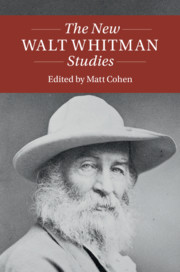Book contents
- The New Walt Whitman Studies
- Twenty-First-Century Critical Revisions
- The New Walt Whitman Studies
- Copyright page
- Contents
- Figures
- Contributors
- Acknowledgments
- Introduction
- Part I The New Life of the New Forms: Aesthetics, Disciplines, Politics
- Chapter 1 Whitman’s “Deathbed” Radicalism and Its Modernist Effects
- Chapter 2 Whitman, Women, and Privacy
- Chapter 3 The Poetics of a New Science: “Song of Myself” as Sociology
- Chapter 4 World Wide Walt: Making and Marketing Whitman’s Global Persona
- Chapter 5 Intimacies of Place: Walt Whitman and the Politics of Settler Sensation
- Part II Wet Paper Between Us: New Reading Methods
- Part III A Kosmos: The Critical Imagination
- Index
Chapter 2 - Whitman, Women, and Privacy
from Part I - The New Life of the New Forms: Aesthetics, Disciplines, Politics
Published online by Cambridge University Press: 03 November 2019
- The New Walt Whitman Studies
- Twenty-First-Century Critical Revisions
- The New Walt Whitman Studies
- Copyright page
- Contents
- Figures
- Contributors
- Acknowledgments
- Introduction
- Part I The New Life of the New Forms: Aesthetics, Disciplines, Politics
- Chapter 1 Whitman’s “Deathbed” Radicalism and Its Modernist Effects
- Chapter 2 Whitman, Women, and Privacy
- Chapter 3 The Poetics of a New Science: “Song of Myself” as Sociology
- Chapter 4 World Wide Walt: Making and Marketing Whitman’s Global Persona
- Chapter 5 Intimacies of Place: Walt Whitman and the Politics of Settler Sensation
- Part II Wet Paper Between Us: New Reading Methods
- Part III A Kosmos: The Critical Imagination
- Index
Summary
This chapter examines the critical discussions of Walt Whitman by Richard Chase and Jane Bennett in order to show how critics have used the poet to address the disenchanting political, social, and cultural conditions of their own times, particularly Cold War normativity and drastic climate change respectively. Beyond offering critiques of their times, however, critics have discussed Whitman to suggest alternatives that foster positive attachments to social and environmental justice. Contending that critics always create a “Whitman” to suit their own investments, the chapter urges critics to be explicit about those investments in the poet. Doing so, the chapter argues, frees Whitman from the need to speak the critic’s investments, while allowing criticism to play a more positive role in the present.
- Type
- Chapter
- Information
- The New Walt Whitman Studies , pp. 33 - 49Publisher: Cambridge University PressPrint publication year: 2019

